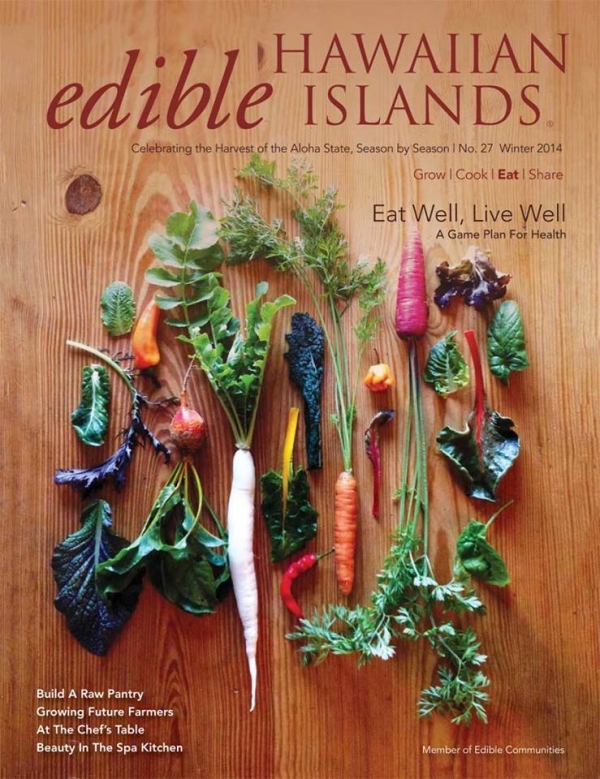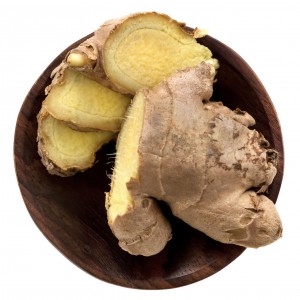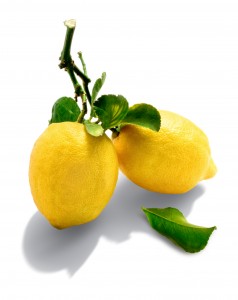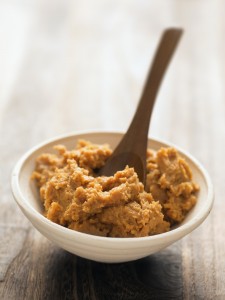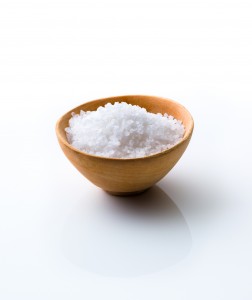Build a Raw Pantry: Nine foods to keep stocked for natural, gourmet meals
The best way to conjure up a great meal at the drop of a hat is to make sure your pantry is stocked with the right ingredients. With the right long-lasting staples on-hand, you can take advantage of foods that are fresh in season, try out new recipes without extensive shopping, or pull together a delicious meal with whatever is in your fridge.
Here are nine pantry staples to enhance a multitude of meals:
1. GINGER
Flavor: Warm, spicy, bitter, sweet
Aroma: Refreshing, woody undertones, sweet citrus overtones
Benefits: Ginger increases circulation, improves digestion and assimilation of nutrients, has anti-inflammatory properties and strengthens immunity.
Buying and Storing: Young ginger has a thin, pale skin and tender, milder and less fibrous flesh; Mature ginger has a tougher skin that generally requires peeling. Look for smooth skin and a fresh, spicy fragrance. To keep ginger fresh for up to three weeks, store in a zip-top bag or sealed container in the fridge.
How to use it: Peel and mince finely to add to dishes. Peel, chop and blend into dressings, marinades, sauces and soups. To extract ginger juice, peel, finely grate and squeeze.
2. NAMA SHOYU (unpasteurized soy sauce)
Flavors: Salty, savory, umami
Aroma: Deep, complex, savory
Benefits: Shoyu is traditionally brewed soy sauce that is aged in wooden casks for several months to several years, which converts soy’s complex proteins and starches into easy to digest nutrients. Nama shoyu is unpasteurized and abundant in healthy microorganisms such as Lactobacillus, which aid digestion and assimilation of nutrients, and help balance intestinal ecology.
Buying and Storing: Look for “shoyu” rather than soy sauce to ensure it is traditionally brewed and cultured, which yields a more robust flavor (and to dodge chemical extraction and solvents used in commercial products). Look for “organic” or “GMO-free” products because most conventional soy products contain genetically modified ingredients. Store nama shoyu in the fridge after opening and it will keep indefinitely.
How to use it: Use nama shoyu as you would use soy sauce to enhance marinades, dressings and sauces.
3. UMEBOSHI PLUM VINEGAR
Flavors: Dynamic, salty, tart, fruity
Aroma: Bright, clean, mildly tangy
Benefits: Umeboshi plum vinegar is the brine from pickling umeboshi plums (it’s not technically a vinegar because it’s not fermented and it contains salt). Its alkaline minerals balance the body and are highly valued to aid digestion and assimilation of nutrients. With a dynamic flavor, it boosts and enhances the flavors of a wide variety of other foods, herbs and spices.
Buying and Storing: Look for umeboshi plum vinegar that does not contain preservatives or colorants. Store in a cool, dry place or in the fridge. Keeps indefinitely.
How to use it: Add to dressings, marinades, sauces and soups to boost salty, bright flavors. Sprinkle on steamed or sautéed vegetable or cooked grains. Umeboshi plum vinegar can be used instead of fish sauce, though the flavor is fruitier and lighter (just be sure to adjust the salt in the dish as umeboshi plum vinegar is quite salty).
4. LEMON
Flavors: Tart, sour, bright
Aroma: Clean, zesty, sweet overtones
Benefits: Lemons are acidic in taste, but alkaline-forming in the body and help restore the body’s pH balance. They’re loaded with immune-boosting Vitamin C, citric acid and antioxidants to neutralize free radicals and renew the body and skin. Valued as a digestive aid and liver cleanser, lemons also have antibacterial and antiviral properties.
Buying and Storing: Look for lemons that are firm, yet yield a bit when squeezed. Avoid fruit with soft spots and discoloration. Hard lemons can be ripened on the counter for a few days and stored at room temperature for about a week, or in the fridge for 2 to 3 weeks.
How to use it: Add a squeeze of lemon juice to water when blanching veggies to retain bright colors. Try adding 2 tablespoons of lemon juice with the water used to cook rice to prevent it from becoming sticky. Grated lemon zest has a bright, concentrated lemon flavor to add zip to sweet and savory dishes.
5. UNREFINED SEA SALT
Benefits: Unrefined sea salts are alkaline-forming in the body. They are a valuable source of trace minerals, which aid the immune system, as well as electrolytes that maintain hydration and support nerve and muscle function. The best sea salts are dried by the sun or at low temperatures to preserve precious elements, minerals and delicate flavors, whereas refined table salt is devoid of minerals and may contain additives such as aluminum silicate and chlorine derivatives for a uniform white color.
Types of Sea Salts
-
Celtic Sea Salt: This pure, naturally moist pale grey sea salt is hand-harvested from Brittany, France and sun-dried using traditional methods that date back 2,000 years. Available in coarse and fine grind for a clean taste and delicate finish.
-
Hawaiian Red Sea Salt: This burnt-crimson colored salt is infused with the legendary, medicinal red ‘Alae clay of Hawaii and has a slightly nutty flavor.
-
Hawaiian Black Lava Sea Salt: This glistening, charcoal colored salt is infused with lava rock for a complex flavor and mineral finish.
-
Himalayan Crystal Salt: This rosy, pink colored salt is harvested from salt veins in the Himalayan mountains from sea salt beds that are 250,000 million years old (yes, really). The crystals are very dense and intensely salty so a little goes a long way. Himalayan salt is available in fine and coarse grind.
-
Maldon Sea Salt: This flaky salt from the UK’s North Sea has a delicate, pyramid-shaped crystal that provides a salty crunch for finishing a dish.
-
Smoked Sea Salts: These salts are naturally smoked over wood fires to infuse a deep, distinctive smoky aroma and flavor. Look for natural smoked salts that do not contain artificial flavors
6. AGED BALSAMIC VINEGAR
Flavors: Pungent, sweet, tangy (the older, the smoother and sweeter it is)
Aroma: Pithy, piquant overtones, sweet undertones (the older, the more complex the bouquet)
Benefits: Balsamic vinegar is mineral-rich and loaded with antioxidants, which counter free radical damage and also help the body digest and absorb proteins. Aged balsamic vinegar is more mellow and sweet and lends a complex flavor to balance and boost recipes.
Buying and Storing: Look for balsamic vinegar that has been aged at least 10 years (and up to 25 years) and has a thick, syrupy consistency. Usually, the longer it is aged, the thicker the consistency (because more water has evaporated from it) and the deeper, sweeter and more complex the flavor.
How to use it: Aged balsamic lends complex flavor to dressings, marinades, sauces and grilled foods. Try a drizzle of it over strawberries or pineapple for a surprisingly delicious complement of flavor.
7. COCONUT OIL
Flavors: Buttery, mild to strong quintessential coconut flavor, slightly sweet
Aroma: Mild to strong scent, sweet, floral coconut
Benefits: Coconut oil is highly digestible and a great source of fuel for the body. Its medium-chain fatty acids boost metabolism and can be directly converted into energy by the body instead of being processed by the liver or stored as fat. Coconut oil is loaded with lauric acid, which is great for the immune system. Plus, it’s an extremely stable oil that can hold up to cooking without breaking down and its rich, buttery texture and taste is incredibly satisfying.
Buying and Storing: “Virgin” coconut oil is naturally extracted without heat and has a stronger coconut scent and taste, which works well in recipes that the flavor will compliment. Refined coconut oil has a milder flavor and aroma, which is suitable for a wider array of recipes, including baking and sautéing. Just be sure to look for coconut oil that has been expeller-pressed without the use of chemical solvents, and which doesn’t contain hydrogenated oils.
How to use it: Coconut oil is a delicious plant-based alternative to butter. It acts just like butter – semisolid at room temperature, solid in the fridge – with a delectable, buttery texture that works well in both savory and sweet foods. It can also be used the same way as other oils, such as olive oil or grapeseed oil, in dressings, marinades and sauces.
8. MISO
Flavors: Salty, savory, umami; varies with type of miso; some sweeter, some stronger
Aroma: Rich, complex, nutty, sweet
Benefits: Miso is a probiotic-rich food that aids digestion and assimilation of nutrients and balances intestinal ecology. It’s an enzyme-rich fermented food that is easily digestible by the body and known to boost the immune system and help the body process toxins. Plus, its deep, full-bodied flavor enhances many dishes with complex, umami taste.
Buying and Storing: Lighter colored miso is sweeter, milder and less salty than darker colored miso. Look for some of the most exceptional, locally produced miso at the Kula farmer’s market on Maui. Miso should be stored in the fridge and will keep indefinitely.
How to use it: Traditional miso soup is a familiar association, but miso is a delicious addition to other soups as well as in marinades, dressings and sauces. The enzymes and probiotics in miso are sensitive to heat, so keeping it below 150ËšF will ensure maximum health benefits.
9. RAW HONEY
Flavors: Sweet; varies with type of honey; lighter honey is mild and floral, darker honey is more complex with hints of malt and molasses
Aroma: Distinct honey scent; varies with type of honey; flowery, fruity, caramel
Benefits: Honey contains all of the essential amino acids (the building blocks of protein) and a high concentration of minerals and nutrients, including B-complex vitamins. Raw honey is rich in enzymes, friendly bacteria and antioxidants, plus antibacterial and anti-viral properties; and unfiltered raw honey contains small amounts of bee pollen and propolis, which boost the immune system and protect the body. The bee pollen in local honey may even help thwart seasonal allergies.
Buying and Storing: Look for raw honey that has not been pasteurized or heated; it will have the most flavor and the most benefits for the body. Local honey is the most valuable and sustainable choice to support local farmers.
How to use it: Raw honey is best used at low temperatures (high temperatures will destroy many of its precious properties). Use raw honey for savory and sweet dishes as an alternative to sugar, maple syrup or agave nectar.

